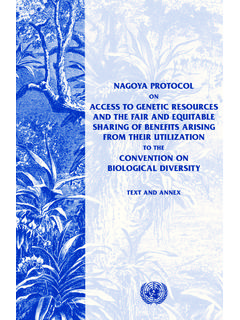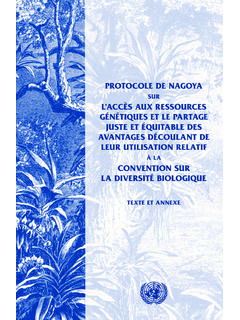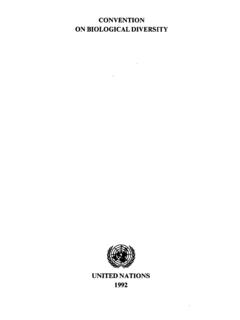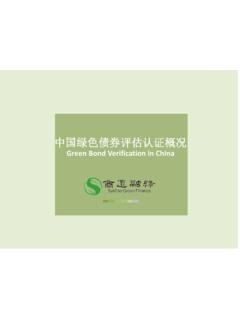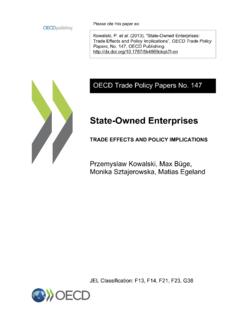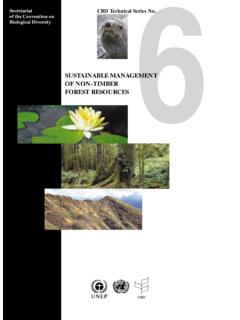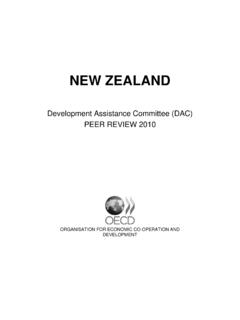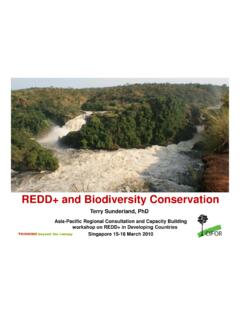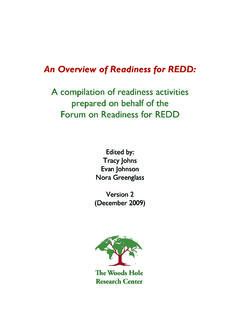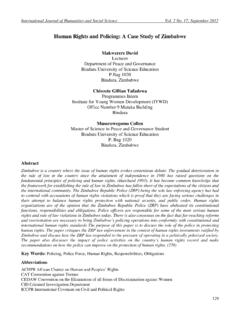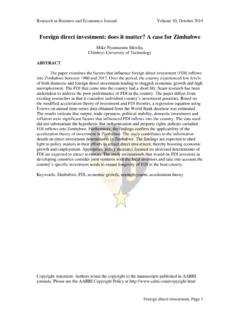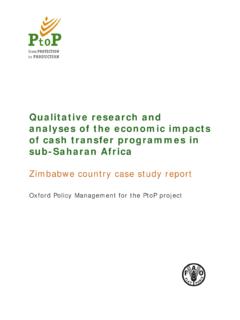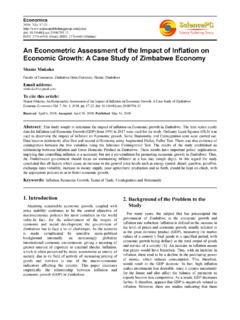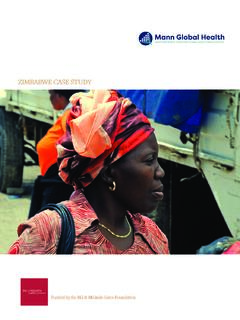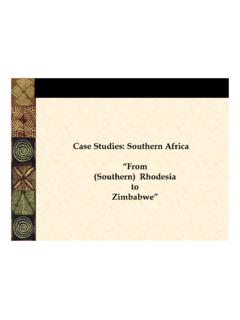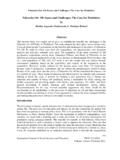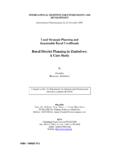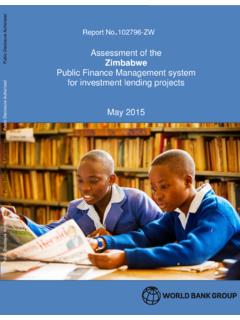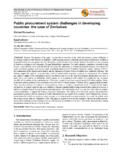Transcription of Zimbabwe Case Study - CBD
1 Biodiversity and Planning Support Programme Zimbabwe case Study Enos M SHUMBA Paper prepared for an international workshop on "Integration of Biodiversity in National Forestry Planning Programme" held in CIFOR Headquarters, Bogor, Indonesia on 13-16 August 2001 August 2001 Zimbabwe case Study iTABLE OF CONTENTS Page No. State of national forest management in Zimbabwe 1 Relative importance of forestry to Zimbabwe s economy 1 Main forest production areas 2 National Forest Programme 4 History of forest management in Zimbabwe 4 Policy framework and institutional structure for timber exploitation 6 Overview of the present state of biodiversity in Zimbabwe 8 Status of forest biodiversity 8 The status of biodiversity mapping within forest ecosystems 15 Rate of change of forest
2 Biodiversity components 17 Status of forest biodiversity conservation and planning 20 Importance of biodiversity conservation in the country 20 Zimbabwe and the Convention on Biological Diversity 21 Status of forest biodiversity conservation and enhancement 22 Links between logging and biodiversity conservation and planning 27 The contextual framework 27 Problems and constraints to biodiversity conservation under logging 27 conditions Strategies and solutions to link biodiversity conservation and 31 planning References 32 Appendix 33 Zimbabwe case Study STATE OF NATIONAL FOREST MANAGEMENT IN
3 Zimbabwe Relative importance of forestry to Zimbabwe s economy Zimbabwe is a developing country with a per capita income of US$718 (in 1996) based on a total Gross Domestic Product (GDP) of Z$ billion (in nominal terms) and a total population of approximately million. However, the GDP per capita has declined from US$271 in 1980 to US$201 in 1996 in real terms largely due to high inflation and the depreciation of the Zimbabwe dollar. The country s economy depends heavily on natural resources for generating employment, income and foreign exchange. The dominant sectors and their contribution to Zimbabwe s GDP in 1996 were as follows: manufacturing, 17%; agriculture, forestry and fishing, 18%; mining, 5%, and distribution, hotels and restaurants (which includes tourism), 18%.
4 The forestry sector contributes about 3% to the GDP largely from exotic plantations and commercial indigenous timber. However, this figure grossly misrepresents the contribution of forests and woodlands to the country s economy as most of their products and services are not captured in the national level statistics. Such a scenario partly explains why the forestry sector tends to get lower priority in terms of national resource allocation. 1. Exotic plantations The exotic plantation forestry industry accounts for most of the 3% contributed by forestry sector to the GDP.
5 It is highly vertically integrated into timber production, processing, packaging and marketing and employs some 16,000 people. The industry has put considerable investment into plantation development, sawmill and value addition during the last decade. The last four years have seen the emergence of small private sawmills to cater for the lower end of the market. The wood supply and demand picture in exotic plantations is mixed (Arnold and Easton, 1993). Average annual timber consumption in the sector was 656,000m3 between 1987 and 1990 and 541,333m3 between 1989 and 1991. When the most optimistic wood supply scenario of low economic growth, expanded plantation areas and high yields is used, no timber deficits are projected for both pine and eucalypts up to year 2020.
6 The most pessimistic scenario of high economic growth, no expansion of plantation areas and low growth and yield would result in serious wood supply deficits over the same period. However, the most likely scenario lies between the two extremes. 2. Indigenous forests and woodlands Commercial timber production from indigenous forests and woodlands is based on Pterocarpus angolensis and Baikiaea plurijuga. Forests with these species are confined to the western part of the country and occupy only about 5% of the country s total land area. The rest of the country s forests and woodlands have little to no timber of commercial value.
7 The total demand for indigenous roundwood timber in 1989/90 was approximately 50,000m3, while the 1991/92 supplies of high value indigenous hardwoods from concessions in western Zimbabwe was less than Zimbabwe case Study 222,000m3. This means that current demand for such timber cannot be met from the local resource alone. The situation will definitely worsen in future. This gave rise to the recent gazetting of an instrument that bans the export of indigenous timber in the round . The instrument is also meant to promote local timber processing and employment creation.
8 Apart from commercial timber which is limited to one geographical area, the country s indigenous forests and woodlands generate a wide range of products which include fuelwood, small artisan crafts, fodder, fruits, honey, mushrooms, insects, bark for rope, medicines, leaf litter and gum. Services provided by these forests include watershed conservation; carbon fixation; and the provision of windbreaks, shade, soil stability and wildlife habitat. No exact economic value has been established for these goods and services but specific studies can produce some point estimates. For example, a modified contingent valuation Study that estimated the mean direct and incorrect values of a range of timber and non timber products in Miombo woodlands gave an average value of Z$200/ha per year (Campbell et al.)
9 , 1991). Based on this figure (and mindful of many caveats about extrapolating the very specific Campbell results), the total stock value of indigenous woodlands (occupying about 21 million ha of the country can be estimated at Z$ billion per year. Unfortunately, such contributions do not feature in the national accounting system. Main forest production areas Overview of Zimbabwe s forest resources Zimbabwe is characterised by savannah woodlands interspersed with open grassed drainage lines or dambos. Impeded drainage gives rise to limited areas of open grassland and a few patches of sub-tropical forests occur in the eastern districts.
10 The country s forest resources fall into four main categories namely: woodlands, forests and trees in communal and resettlement areas; woodlands and trees in large scale commercial farming areas; woodlands and forests on state lands and in protected areas; and exotic forest plantations. These forest resources are described in this section. 1. Woodlands, forests and trees in communal and resettlement areas Forests in communal and resettlement farming areas cover some 10 million hectares and provide rural households with supplies of construction timber and fuelwood. The quality of this woodland is very variable and largely consists of remnants of scattered trees in what has effectively become open grassland.
